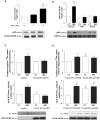Insulin regulates alveolar epithelial function by inducing Na+/K+-ATPase translocation to the plasma membrane in a process mediated by the action of Akt
- PMID: 20332111
- PMCID: PMC2848117
- DOI: 10.1242/jcs.066464
Insulin regulates alveolar epithelial function by inducing Na+/K+-ATPase translocation to the plasma membrane in a process mediated by the action of Akt
Abstract
Stimulation of Na(+)/K(+)-ATPase translocation to the cell surface increases active Na(+) transport, which is the driving force of alveolar fluid reabsorption, a process necessary to keep the lungs free of edema and to allow normal gas exchange. Here, we provide evidence that insulin increases alveolar fluid reabsorption and Na(+)/K(+)-ATPase activity by increasing its translocation to the plasma membrane in alveolar epithelial cells. Insulin-induced Akt activation is necessary and sufficient to promote Na(+)/K(+)-ATPase translocation to the plasma membrane. Phosphorylation of AS160 by Akt is also required in this process, whereas inactivation of the Rab GTPase-activating protein domain of AS160 promotes partial Na(+)/K(+)-ATPase translocation in the absence of insulin. We found that Rab10 functions as a downstream target of AS160 in insulin-induced Na(+)/K(+)-ATPase translocation. Collectively, these results suggest that Akt plays a major role in Na(+)/K(+)-ATPase intracellular translocation and thus in alveolar fluid reabsorption.
Figures






Similar articles
-
Src kinase integrates PI3K/Akt and MAPK/ERK1/2 pathways in T3-induced Na-K-ATPase activity in adult rat alveolar cells.Am J Physiol Lung Cell Mol Physiol. 2011 Nov;301(5):L765-71. doi: 10.1152/ajplung.00151.2011. Epub 2011 Aug 12. Am J Physiol Lung Cell Mol Physiol. 2011. PMID: 21840963
-
Akt Substrate of 160 kD Regulates Na+,K+-ATPase Trafficking in Response to Energy Depletion and Renal Ischemia.J Am Soc Nephrol. 2015 Nov;26(11):2765-76. doi: 10.1681/ASN.2013101040. Epub 2015 Mar 18. J Am Soc Nephrol. 2015. PMID: 25788531 Free PMC article.
-
3,3',5-Triiodo-L-thyronine up-regulation of Na,K-ATPase activity and cell surface expression in alveolar epithelial cells is Src kinase- and phosphoinositide 3-kinase-dependent.J Biol Chem. 2004 Nov 12;279(46):47589-600. doi: 10.1074/jbc.M405497200. Epub 2004 Aug 31. J Biol Chem. 2004. PMID: 15342623
-
Thyroid hormone rapidly stimulates alveolar Na,K-ATPase by activation of phosphatidylinositol 3-kinase.Curr Opin Endocrinol Diabetes Obes. 2007 Oct;14(5):416-20. doi: 10.1097/MED.0b013e3282f02ae8. Curr Opin Endocrinol Diabetes Obes. 2007. PMID: 17940473 Review.
-
Hypoxic inhibition of alveolar fluid reabsorption.Adv Exp Med Biol. 2007;618:159-68. doi: 10.1007/978-0-387-75434-5_12. Adv Exp Med Biol. 2007. PMID: 18269195 Review.
Cited by
-
Predictive model for acute respiratory distress syndrome events in ICU patients in China using machine learning algorithms: a secondary analysis of a cohort study.J Transl Med. 2019 Oct 1;17(1):326. doi: 10.1186/s12967-019-2075-0. J Transl Med. 2019. PMID: 31570096 Free PMC article. Clinical Trial.
-
Modulation of Na(+)-K(+)-ATPase cell surface abundance through structural determinants on the α1-subunit.Am J Physiol Cell Physiol. 2011 Jan;300(1):C42-8. doi: 10.1152/ajpcell.00386.2010. Epub 2010 Nov 3. Am J Physiol Cell Physiol. 2011. PMID: 21048163 Free PMC article.
-
Hypotonic shock modulates Na(+) current via a Cl(-) and Ca(2+)/calmodulin dependent mechanism in alveolar epithelial cells.PLoS One. 2013 Sep 3;8(9):e74565. doi: 10.1371/journal.pone.0074565. eCollection 2013. PLoS One. 2013. PMID: 24019969 Free PMC article.
-
Salt-inducible kinase 1 is present in lung alveolar epithelial cells and regulates active sodium transport.Biochem Biophys Res Commun. 2011 May 27;409(1):28-33. doi: 10.1016/j.bbrc.2011.04.100. Epub 2011 Apr 28. Biochem Biophys Res Commun. 2011. PMID: 21549091 Free PMC article.
-
Regulation of Lung Epithelial Sodium Channels by Cytokines and Chemokines.Front Immunol. 2017 Jul 25;8:766. doi: 10.3389/fimmu.2017.00766. eCollection 2017. Front Immunol. 2017. PMID: 28791006 Free PMC article. Review.
References
-
- Al-Khalili L., Yu M., Chibalin A. V. (2003). Na+,K+-ATPase trafficking in skeletal muscle: insulin stimulates translocation of both [alpha]1- and [alpha]2-subunit isoforms. FEBS Lett. 536, 198-202 - PubMed
-
- Bertorello A. M., Ridge K. M., Chibalin A. V., Katz A. I., Sznajder J. I. (1999). Isoproterenol increases Na+-K+-ATPase activity by membrane insertion of alpha-subunits in lung alveolar cells. Am J. Physiol. Lung Cell Mol. Physiol. 276, L20-L27 - PubMed
-
- Bertorello A. M., Komarova Y., Smith K., Leibiger I. B., Efendiev R., Pedemonte C. H., Borisy G., Sznajder J. I. (2003). Analysis of Na+,K+-ATPase motion and incorporation into the plasma membrane in response to G protein-coupled receptor signals in living cells. Mol. Biol. Cell 14, 1149-1157 - PMC - PubMed
Publication types
MeSH terms
Substances
Grants and funding
LinkOut - more resources
Full Text Sources
Medical

